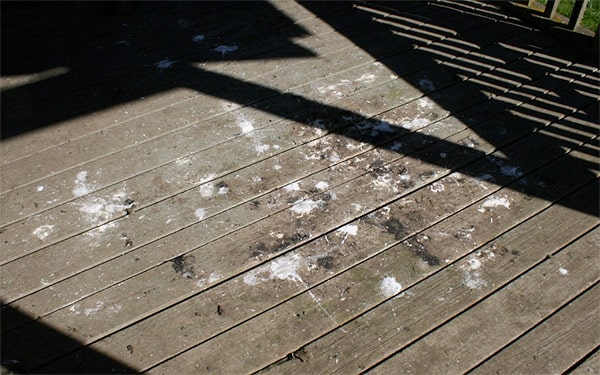Flamingos are infamous for their bright pink color, which we know is due to their diet of brine shrimp.
And those brine shrimp get that pink hue from the microscopic blue-green algae that they eat.
That blue-green algae, which despite their name, are actually red or orange in color due to a chemical known as beta carotene.
With this in mind, it’s natural for you to wonder if flamingo poop is also pink.
We’ve got the answer to this mystery for you below.

What Color Is Actual Flamingo Poop?
Wouldn’t it be cool if flamingos have poop that is as bright pink as their feathers?
If you want to know if flamingo poop is pink, the answer is no.
Sadly, that brine shrimp that gives flamingos their brilliant pink color does not do the same to their excrement.
Yup, when that brine shrimp makes it through the flamingo digestive system and comes out the other end, it looks like any other bird poop that you’ve seen.
The color of flamingo poop is that grayish-brown and white color that you see from most bird droppings.

So, it’s not really distinguishable from other birds that are pooping in the same area as the flamingo.
And it doesn’t matter what the flamingo eats, because the color of the poop is never pink.
There is one small exception to this.
When flamingo chicks are really young, their poop may look slightly orange but this is due to them processing the yolk they lived off of in the egg.
Similar myths suggest that the egg and egg yolk of a flamingo is also pink, but these claims are ultimately refuted by experts.
That means the only thing from or on a flamingo that is pink is its exterior coloring. And that’s only if it is eating the brine shrimp.
What Makes A Flamingo Pink?
Some people wonder if flamingos are pink because of blood. The answer to that is, no.
Flamingos are born with gray plumage. They get their rosy hue pink by ingesting a type of organic pigment called a carotenoid.

They obtain this through their main food source, brine shrimp, which feast on microscopic algae that naturally produce carotenoids.
Enzymes in the flamingos’ liver break down the compounds into pink and orange pigment molecules, which are then deposited into the birds’ feathers, legs and beaks.
What Happens If A Flamingo Doesn’t Eat Shrimp?
If flamingos didn’t feed on brine shrimp, their lovely pink plumage would eventually fade.
In captivity, the birds’ diets are supplemented with carotenoids such as beta-carotene and and canthaxanthin.
Beta-carotene, responsible for the orange of carrots, pumpkins and sweet potatoes, is converted in the body to vitamin A.
Canthaxanthin is responsible for the color of apples, peaches, strawberries and many flowers.
Shrimp can’t produce these compounds either, so they too depend on their diet to color their tiny bodies.
Final Word
Unfortunately, the same food that gives flamingos their pink coloring does not transform the color of their poop.
Just like most other birds out there, flamingos have the same yucky bird droppings that are that grayish-brown and white color.
So, the next time you’re at the zoo checking out the flamingo exhibit, you don’t have to waste time hoping one poops so that you can check the coloring of the droppings.
